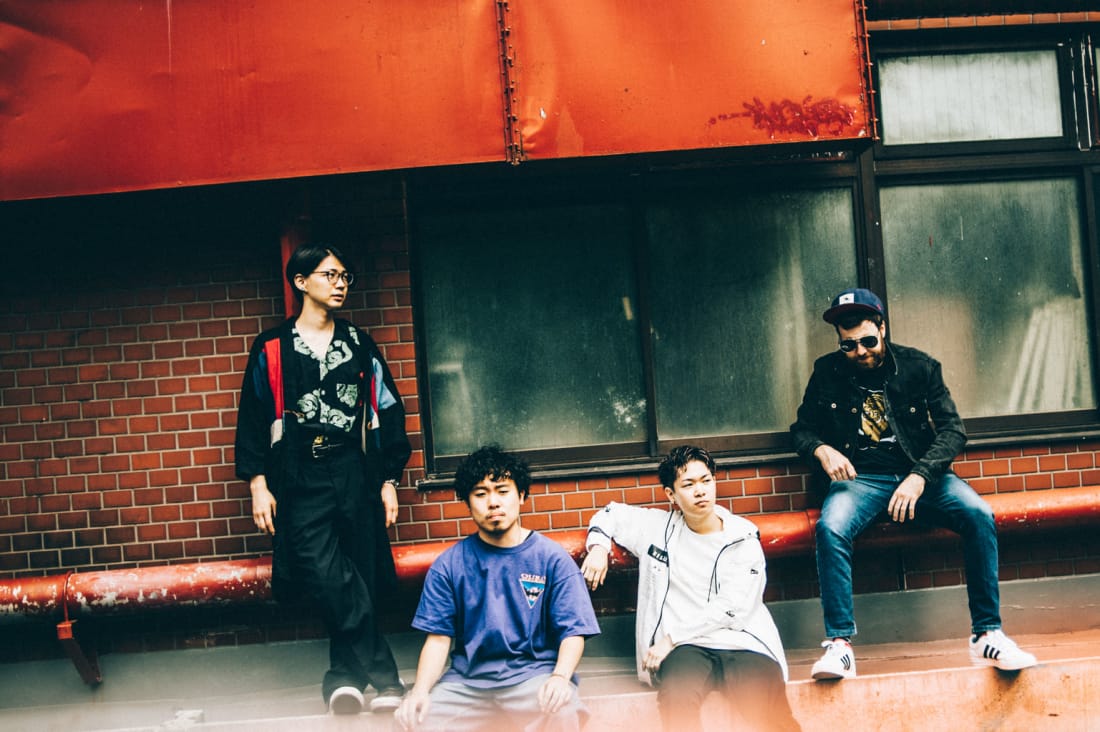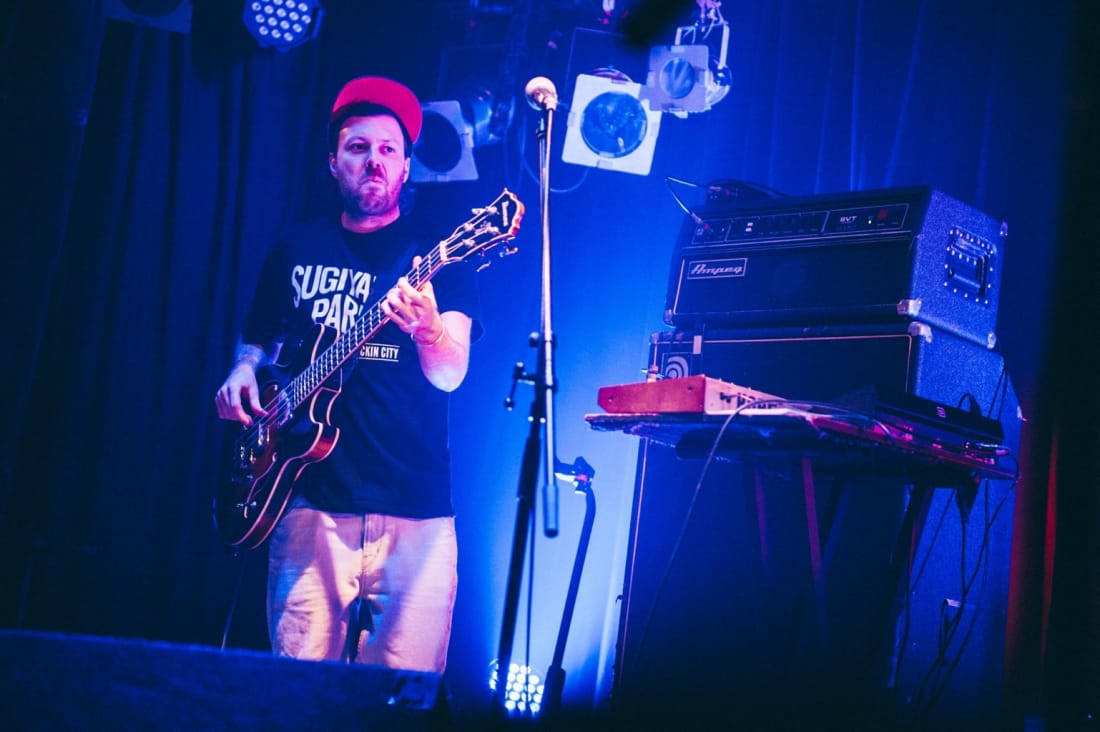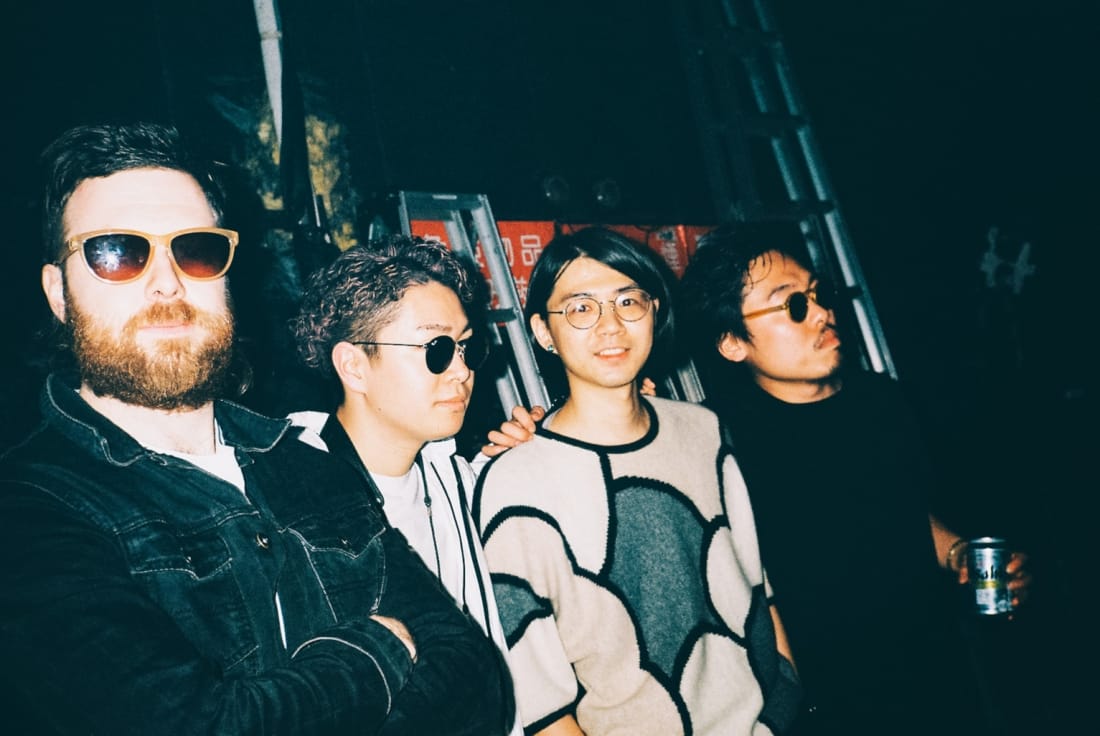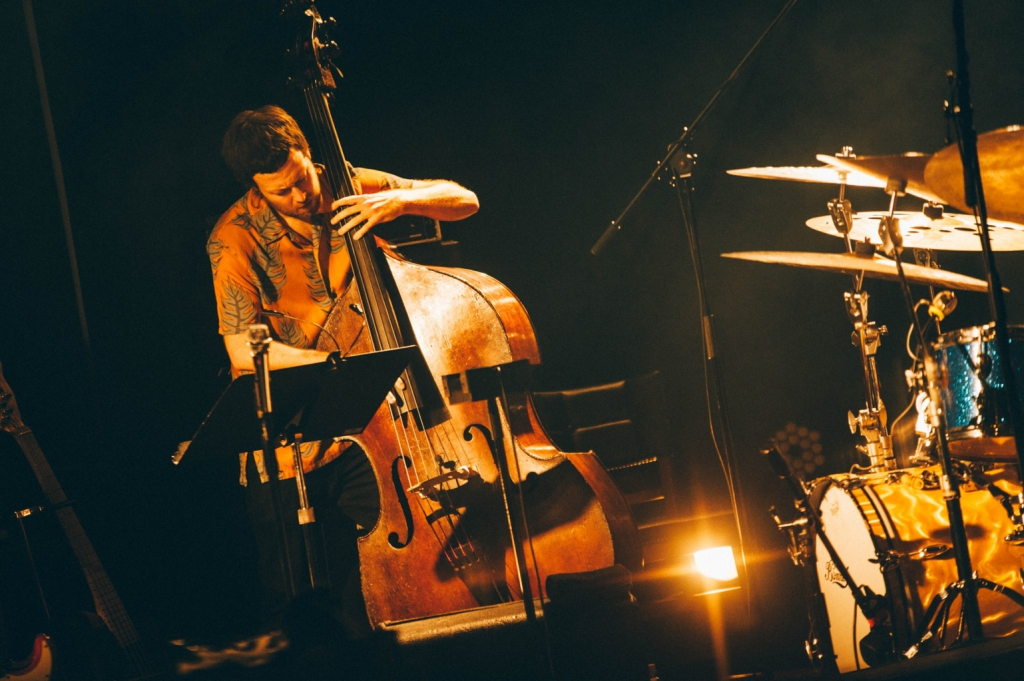Jazz bassist Marty Holoubek first came to Japan on a maybe-vacation with The Lagerphones in 2015. The Melbourne-based band ended up playing some 11 shows in 10 days plus four photoshoots and a number of interviews. The intensity of this touring sequence would come to define his career from then on.
In addition to The Lagerphones and a part in NHK’s television series Musica Piccolino, Holoubek, who has since moved to Tokyo, has kept busy with the release of his solo album and, most recently, touring with the rock and jazz quartet SMTK.
With Holoubek on bass, Shun Ishiwaka on drums, Tokutaro Hosoi on guitar and Kei Matsumaru on saxophone, the group has performed the herculean task of standing out in Tokyo’s vibrant and ever-exploratory music scene.
SMTK released their first full-length album, SUPER MAGIC TOKYO KARMA, in late May. The individual tracks are just as eclectic as the album’s title. Free jazz is the foundation of this album, the starting point, and they go in all sorts of directions from there: ska (“Otoshi Ana”), math rock (“My Country is Burning”), garage rock (“Let Other Be the Judge of You”). This genre-bending is what distinguishes SMTK from their contemporaries, while hearkening to the tradition of improvisation so integral to jazz.

Photo by Kana Tarumi
Tokyo Weekender chatted with Holoubek ahead of SMTK’s livestream release party for their new album to discuss a little music history and jazz in Japan pre- and post-pandemic. As he returns to doing live gigs, albeit over livestream, he worried that he is “out of shape,” that “the physicality of the instrument is the thing that has left [him] the most.” However, quarantine has proved a period of intense study and reflection. Holoubek got to actually sit down and listen to music the same way you would watch a film, “as the artist intended,” he says.
This plain appreciation for and documentarian knowledge of music flowed through his language as he detailed diverse peers, historical figureheads and genre luminaries. It seems the Tokyo jazz world, in all its diversity and quirk, has become a second home for him.
You’ve collaborated with Jim O’Rourke and Eiko Ishibashi. For experimentalists like them and yourself, what does this process of collaboration look like? Before the gigs, what guidelines are laid out?
There would definitely be more planning and structure behind the recordings, or things can be manipulated after they’ve been recorded, you know. For the first gig [with Jim], there were some plans for it – we were playing the music of a great drummer named Paul Motian. But we didn’t have a rehearsal or anything like that.
Melbourne has an incredible improvised music scene. I was lucky enough to have a foundation in that kind of world. But still, I’m here with Jim and the great drummer-electronic artist Joe Talia and I have no idea what they like or what I can contribute, but it’s more about bringing yourself to the situation and trusting your ear. Ever since then, those gigs have been completely improvised. You walk up, you do a soundcheck and then it’s like, Okay, cool. We’ll start the set at 8 o’clock. Let’s go. It’s pretty fun and pretty terrifying. There have been incredibly beautiful moments that come from that.

Photo by Kana Tarumi
When you came to Japan, were you introduced to genres you haven’t heard about? You can call city pop distinctly Tokyo; ska is pretty big here, reggae is big here.
Absolutely. City pop to me is incredible – this driving late seventies-eighties music with really wild synthesizers, and Japan’s history of developing all these incredible new sounds and synthesizers. And within the Japanese jazz scene, there are so many subcultures and subgenres that are so unique.
What’s the weirdest subculture you’ve encountered?
A lot of the noise musicians are pretty wild and obscure. I’ve seen some really experimental stuff where it’s using, like, microphones in water.
To say the very least, SMTK’s new album draws from a variety of musical genres. Did you guys approach the album with the intention of playing jazz fusion or was this variety the organic outcome of the “brainstorming” stage?
Definitely more an organic thing. It was never an intentional We’re going to make a ska track or we’re going to make a math rock tune. While the EP is very dear to our heart, it contains some songs we had written and played for different bands. The album was like, We’ve written these songs, now what can we make them? I guess “Otoshi Ana,” the ska-trap tune, was the closest to having an influence. We all like trap music, so we thought maybe we should try and write a trap tune. The ska guitar chunk was Tokutaro [Hosoi] improvising. That hectic drum and bass are pretty wild.
On that note, who are the most prominent musical or conceptual influences on this album?
The Yosuke Yamashita Trio, that free jazz, heavy stuff is a big influence. There’s also Ornette Coleman, Thelonious Monk – we even used to play a lot of their music. We’re all into a lot of contemporary pop music too. I’m personally a massive fan of Charli XCX and Caroline Polachek. Improvising is a big part of our performances, and we like to bring that to whatever we do, so noise music and improvisation is also a big part of the album as well.
You wrote the song “My Country is Burning” for the SMTK album. Is this about the Australian fires? If so, how did you approach portraying such catastrophic events through the musical ensemble?
“Because of all the smoke, you couldn’t see anything”
Both physically and conceptually, this was very close to home because I went back [to Australia] last Christmas, and I remember… Normally flying into Sydney, you can see the city and the harbor. It’s beautiful flying into there. But this time, because of all the smoke, you couldn’t see anything. There was about 5,000-foot visibility. We suddenly, just, land. It was scary, and at this stage it was still quite early on. Then I flew from Sydney to Adelaide, my hometown, which also had some pretty hectic bushfires, just when they were starting. It just got worse for months. Those scenes were a big inspiration for this tune.
It starts out math rock-y, this tough riff. But then it kind of collapses and goes into this rampant, driving section with noise saxophone and tough guitar riffs and synth basses. I guess that was the symbolic representation of what was going on in Australia at the time, ending with the math rock section again. It’s still here, but at least we’re out of the hecticness.
The Tokyo jazz scene is vibrant. There has also been this wave of new popular jazz in the West. Has this revival been palpable to you?
In my line of work, I do have to deal with a lot of purists who believe that everything that came after 1950 or 1960 was destroying the integrity of older jazz. Jazz has always been this evolving thing; it’s never stopped since its creation back in the ’20s. It’s always been about pushing musical boundaries. I’m really excited and happy it’s back to getting attention.
I think its popularity comes in waves. In the ’90s, you had acid jazz and it was like, Oh, jazz is popular again! Then that went away, then people like Jamiroquai came, this disco sound with heavy jazz influence. Nowadays, Kamasi [Washington], Thundercat and Flying Lotus are bringing it back to the forefront.
In Japan, I feel like J-pop has this serious harmony that’s so jazzy, making it stand out to other pop around the world. I wonder if that’s because of the heavy American influence of the ’50s in Japan, and the country’s subsequent jazz obsession. Still, here, they are really into jazz. Maybe that love transcended into pop music, whether it’s the feel or the melodies. This revival is making it more palatable for young audiences, I think.

Photo by Kana Tarumi
How would you characterize the contemporary (or pre-corona) Tokyo jazz scene?
One of the interesting things about corona is that everyone is in the same boat, the whole world – no one can do gigs right now. But being musicians, we always have this thing we can work on and keep developing. That’s helped a lot of people keep their sanity I think.
The Tokyo scene is interesting. Every place in the world has pockets of different cultures – the hard jazz scene, the experimental scene. Like Australia, Japan has adopted this American music – because jazz comes from Black American culture – and they’ve made it their own here. Japan in particular has a big focus on original music.
How have you gone about promoting the SMTK album remotely? Does SMTK have any upcoming gigs or events?
“We put out the first EP pretty much just as coronavirus obliterated everything”
I’ve definitely had this itch to be putting out stuff at this time. There’s another project I’m working on with the [SMTK] saxophone player, Kei Matsumaru, with the ambient music-maker Marty Hicks. This new EP will be out soon, hopefully. But the way SMTK started – we had a bit of a following. We had all these gigs, and a bit of a fanbase was coming, so the momentum was happening. We put out the first EP pretty much just as coronavirus obliterated everything. Due to the “loyal fanbase,” or people interested in the music, we got a bit of traction with that. This new album – there have been a lot of articles in the Japanese press about it. Because a lot of people have the time, now, to scroll through the Internet, they’ll stumble across this stuff.
Anything you want to drive home in these turbulent times?
It’s important to acknowledge that all of the music that everyone in this band has been influenced by has definitely stemmed from Black culture. If people can read up and educate themselves on this history, it will help create a more rewarding and culturally diverse [musical] experience for everyone. Check out early jazz – Louis Armstrong, Miles Davis’ band – and you can hear it’s influencing everything, both jazz and experimental music. It’s so much of what we do. It’s what we come from.
Check out SMTK’s album-release show, streamed from Shinjuku MARZ, on June 25, 2020.
Feature photo by Kana Tarumi








